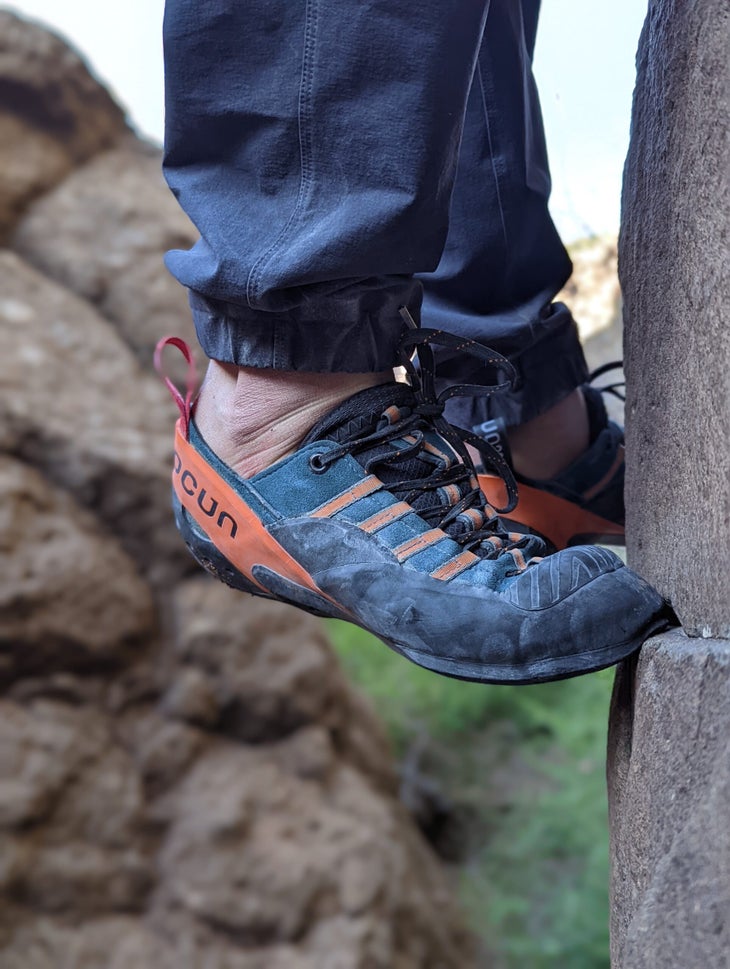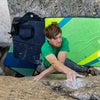Heading out the door? Read this article on the new Outside+ app available now on iOS devices for members! Download the app.
Our thoughts about Ocun’s Sigma
I’ve been on a soft-shoe kick lately, largely because brands are leaping to release new indoor-focused shoes in time for the Paris Olympics. These shoes—notably La Sportiva’s new Ondra Comp and Scarpa’s Veloce L—served me well on the steep, south-facing basalt sport caves where I spent my winter. But with spring’s arrival, I traded the hot caves for some desperately thin, dead-vertical 5.13s at my local shoulder-season crag, and it immediately became clear to me that those soft shoes weren’t going to cut it. So I pulled Ocun’s Sigma out of their winter retirement, and I was glad that I did. I’ve never stood on smaller feet more comfortably. Multiple times these past two weeks, I’ve held my breath when committing my full weight to almost-imaginary credit-card-size feet. The Sigma was up for the challenge.
Check them out on Backcountry.com.
Edging & structure
Ocun has done something interesting with the Sigma’s split-sole design, extending the midsole rubber well past the arch and thickening it as it approaches the heel. The result is a shoe that essentially does not bend in the arch area. This gives you a ton of underfoot support when standing on tiny edges. But thanks to its asymmetry and downturn, the Sigma retains just enough under-foot flexibility to (a) bend upward for slopers and toe hooks, and (b) bend downward in a grabbing motion when you’re trying to toe-in on crimps in the steeps.

That said, the Sigma is designed for a specific range of steepness. It functions incredibly well on vertical to 30-degree overhanging terrain, which happen to be by far the most common sport-climbing angles. In this range of steepness, the shoe’s shape—its downturned and highly asymmetrical last—allows it to grab during high steps and is just flexible enough to perform well on the sorts of smears you’re likely to find at that angle. But the shoe just isn’t designed for the more intense smearing you’ll find on, say, comp volumes; nor is it great for the sorts of grabbing you do on a steep Kilter Board. Plus, on walls less than vertical, the aggressive shape is just plain uncomfortable.
To me, all of those facts are refreshing.
I’ve worn shoes that are designed to “do it all”—but those shoes tend to excel at very little. The Sigma knows its lane and shines there. If I were leaving for Céüse or Siurana or the New River Gorge tomorrow, the Sigma would be the first thing in my bag. But I’ll leave it behind on my next trip to the gym.

How Ocun’s Sigma compares to its closest rival: the La Sportiva Miura VS
Ocun, a Czech brand, is relatively unknown in the U.S. climbing shoe market (I reviewed their soft and compy Nitro’s in 2022 and liked them), so I think comparing the Sigma to some other shoes might be helpful—particularly because, for me, it fills the exact same niche as one of America’s most popular shoes: the Miura VS. (It’s also not dissimilar in edging aptitude to the Katana Lace, but it’s far more aggressive, with better performance in the steeps.)
I’ve been climbing in the Miura VS off and on since it was first released in 2008 because I think it’s one of the best edging sport climbing shoes out there. (Read my review here.) Like the Miura, the Sigma is an almost magical combination of stiffness and sensitivity: not only can you stand on the tiniest of footholds, you can feel them underfoot. But there are some differences.

Shoe designers are constantly trying to overcome an unfortunate paradox related to edging performance: stiffness and sensitivity are antithetical to one another and yet modern sport climbers want (and need) both. In order to achieve this balance, La Sportiva made the Miura VS with a single piece of sole rubber—as opposed to the split-sole design—but thinned this rubber where it runs under the arch, thus adding a bendy sensitivity at the cost of underfoot support. The result is a shoe whose function drastically evolves over the course of its life. Out of the box, it’s an amazing edging shoe. After a few weeks or months of use, it’s better at grabbing and smearing but less solid on dime edges—and more prone to tiring your feet out after multiple pitches.
The Sigma, as far as I can tell, doesn’t change. This is in part because, despite the split sole design, it’s a far stiffer shoe than the Miura VS, particularly under the arch of the foot, where the rubber is thicker and stiffer than it is anywhere else on the shoe. Furthermore, because it’s made with synthetic microfiber, the upper doesn’t soften and change as you sweat it in. After more than 15 days wearing this shoe—sometimes in the gym, often outside—I still feel like I can stand my full weight on minuscule footholds.
(An added bonus for Sigma users: Unlike the Miura VS, with its three velcro straps, the Sigma has a flat lace-closure system and a generous rubber toe swatch. As a result, the Sigma is a much better toe-hooking shoe—something that gives it an advantage for more new-school climbers looking for that kind of functionality.)
What I don’t love…
The Sigma has an extra long sock-like tongue with a built-in lace pocket. The lace pocket is theoretically useful for toe hooks, since it helps tuck the knot out of the way, but in reality, you almost never toe hook onto your ankle, so it felt like an unnecessary addition. More importantly, and annoyingly, I found the long sock quite uncomfortable because, when you’re pulling the shoe on, the extra material often gets bunched up deep on the side of your arch, forcing you to fish around with your fingers to try to straighten it all out. A minor complaint—but putting on your climbing shoes shouldn’t be a multi-minute process.
Sizing
Ocun shoes run smaller than other European shoe brands. I am a U.S. 9.5 or 10 street shoe but I sometimes size my climbing shoes down 3 to 4 sizes. My go-to size for downturned rock shoes range from European 38.5 to European 39.5. In the Sigma, I wear a European 41 / U.S. 8, and I’d be pretty miserable in a 40.5. Ocun has a helpful sizing chart, however. I did exactly what they recommend for those of us who like our shoes “extremely snug”: I went down 1.5 sizes off my U.S. street shoe size—from 9.5 to 8—and I think that’s perfect for me.
Shape
Better for narrower or mid-width feet. The synthetic, rubber-lined upper doesn’t stretch much, and it’s bound by additional sections of rubber, so the shoe may not be friendly for wide feet.
Check it out on Backcountry.com
